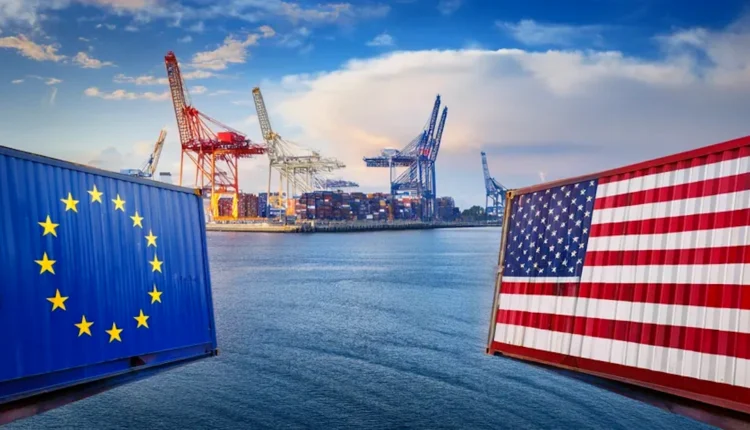Brussels, October 2025 – The Eurozone’s trade surplus surged to a staggering €19.4 billion in September 2025, data showed on Friday, dramatically reversing a period of stagnation and providing the clearest evidence to date of the economic boost from a landmark new trade agreement with the United States.
The latest figures from Eurostat reveal a remarkable turnaround from a €1.9 billion surplus in August and a significant improvement on the €12.9 billion recorded in the same month last year. The data indicates that the US-EU Trade and Cooperation Act, implemented in August, has successfully catalyzed transatlantic commerce after months of disruption caused by tit-for-tat tariffs.
A Surplus Powered by Transatlantic Trade
The September surge was driven by a sharp 7.7% year-on-year increase in exports from the euro area to the rest of the world, which reached €256.6 billion. While imports also grew by 5.3% to €237.1 billion, the growth in exports far outpaced them, resulting in the widened surplus.
The transatlantic corridor was the undisputed engine of this growth. Exports to the United States jumped to €53.1 billion in September, a striking 15.4% increase compared to September 2024. This made the US the Eurozone’s fastest-growing major export destination. Imports from the US also grew healthily by 12.5% to €30.9 billion, but the net effect was a sharp improvement in the trade balance with the US, which widened to €22.2 billion from €18.5 billion a year prior.
The deal, negotiated over the summer by European Commission President Ursula von der Leyen and US President Donald Trump, replaced a complex web of sector-specific tariffs and threats with a simplified, blanket 15% tariff across most major sectors, including automobiles, semiconductors, pharmaceuticals, and agricultural goods.
“These numbers are the first hard evidence that the agreement is delivering on its primary promise: to reduce trade friction and boost flows,” said Anya Schmidt, a trade analyst at Berenberg Bank. “Businesses on both sides of the Atlantic appear to be responding to the newfound predictability.”
Sectoral Shifts and Global Rebalancing
The benefits of the deal were not evenly distributed. A deep dive into the data shows the chemicals sector was the primary driver of the surplus. For the broader EU, the chemical trade surplus ballooned to €26.9 billion in September, up from €15.4 billion the previous month, suggesting European chemical producers are among the biggest early winners.
In contrast, the traditionally robust surplus in machinery and vehicles narrowed from €16.4 billion to €13.8 billion, indicating potential competitive pressures or a shift in supply chains that analysts say warrants further monitoring.
Globally, the reorientation of trade flows is becoming starkly apparent. While trade with the US boomed, exports to China fell by 2.5% year-on-year, reflecting the dual pressures of subdued Chinese domestic demand and a strategic pivot by European exporters toward the more welcoming US market. Exports to other key partners were mixed, with strong growth to India (+7.7%) and Mexico (+11.1%), but a slight decline to Türkiye (-1.5%).
Clouds on the Horizon: Political and Institutional Challenges
Despite the strong monthly performance, a year-to-date view tempers the optimism. For the first nine months of 2025, the euro area’s surplus stands at €128.7 billion, down from €134.3 billion in the same period last year, a reminder of the significant damage inflicted by trade tensions earlier in the year.
Furthermore, the agreement itself is now facing its first major political test. Critics argue the deal was built on a fragile foundation.
“The agreement was, from the outset, a bad and unstable one,” said Ruben Segura-Cayuela, an economist at Bank of America. “It papered over fundamental disagreements with a simple tariff rate, leaving crucial issues like regulatory alignment and the scope of covered sectors dangerously ambiguous.”
These unresolved issues are now coming to a head. Key commitments from the European side, notably promised tariff cuts on certain industrial goods, have yet to be finalized due to the complex process of securing approval from the EU’s 27 member states. Contradictions also persist in sensitive areas like energy, defence procurement, and investment screening.
Next week, the European Commission is expected to present a new implementation plan to Washington, aiming to clarify these commitments and demonstrate progress. The meeting is being viewed as a critical litmus test for the deal’s longevity.
“The Commission is in a difficult position,” said a Brussels-based diplomat, speaking on condition of anonymity. “It negotiated the deal, but it now depends on member states with often divergent economic interests to follow through. Any perceived delay or backtracking could prompt a swift and punitive reaction from the Trump administration.”
The soaring September surplus, therefore, paints a picture of both immediate economic success and looming political risk. While European exporters are cashing in on the new terms, the architects of the deal in Brussels are racing against time to ensure its shaky foundations do not crumble, potentially reviving the very trade wars it was designed to end.
Support Dawat Media Center
If there were ever a time to join us, it is now. Every contribution, however big or small, powers our journalism and sustains our future. Support the Dawat Media Center from as little as $/€10 – it only takes a minute. If you can, please consider supporting us with a regular amount each month. Thank you
DNB Bank AC # 0530 2294668
Account for international payments: NO15 0530 2294 668
Vipps: #557320



Comments are closed.